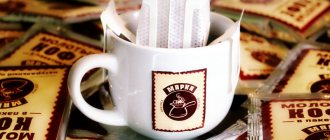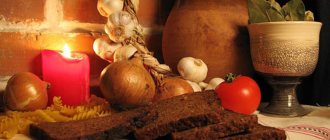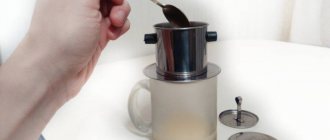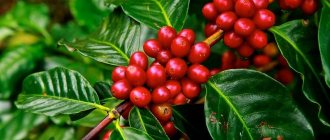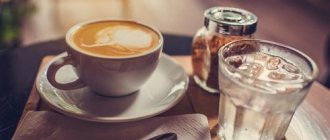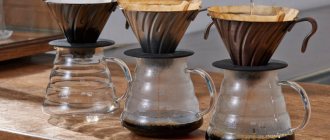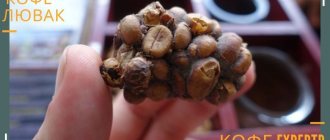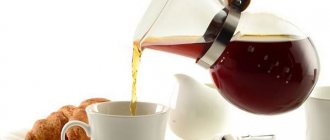It seems that nothing new can be invented in the process of brewing coffee. Meanwhile, this is not entirely true. One of the new products in the coffee industry is pour over.
This method of brewing coffee involves pouring hot water through a special device equipped with a filter and filled with ground coffee . It is because of the brewing method used that it got its name, because... The term “pour over” literally means “pour from above” when translated from English. In addition to the brewing method, the term “pour over” is also attached to the device with which the preparation is carried out.
Enjoy your coffee!
And remember that there is always room for experimentation - try different grains, change the grind size, change the water temperature, or try putting a couple of ice cubes or frozen fruit slices in a cup, this will give the drink a special sweetness. Try an alternative recipe called Pour Over Coffee. Making coffee in the Hario V60 is similar to any other pour-over machine, such as a Chemex or Drip coffee maker, you will find their recipes in our articles.
History of appearance
Coffee is quickly gaining popularity, and passionate fans of this drink are emerging. Asian countries were no exception in this regard. Beginning in the 20th century, pour-over brewing began to gain popularity here. The ground coffee was slowly and evenly poured over a very thin stream of hot water, as if drawing spirals on the coffee. The whole process took about 2 minutes.
Residents were very impressed with this method of preparation, because... in many ways resembled the process of making tea.
Beginning in the mid-50s of the twentieth century, this technique was adopted by one of the manufacturing companies, which began producing cookware that allows brewing coffee using the pour-over technique. This utensil has become very popular and is actively used in public catering establishments.
The British gave the name to this coffee ceremony, calling it pourover.
5 years later, the pour-over appeared in the USA, where it was liked by Americans and lovers of various exotic innovations, and a little later Europe became acquainted with the pour-over.
Today, a device called a pourover can be bought in almost any store that sells coffee products.
What is pour over and how to make coffee in it
Pourover is translated from English as “pour from above.” And this most accurately describes the brewing method, when hot water is poured through a funnel with fresh ground coffee contained in a paper filter.
Despite the English name, pour-over originally came from Japan, where it appeared since 1908. The authors of the method, at the beginning of the last century, came up with a spectacular ceremony characteristic of the Japanese, which looks very much like a traditional teahouse, but is used specifically for brewing coffee.
And the best specialized cookware is produced by the Japanese company Hario. That’s why Hario is also the second common name for pourover. Hario has been a manufacturer of glass products for a variety of purposes for over a century.
For example, glassware for medicine and the chemical industry. And of course, accessories for making tea or coffee. By and large, the name of this Japanese company has become a household name. After all, the devices produced by Hario (pour-overs and French presses, as well as kettles and coffee decanters) have long had an excellent reputation and are highly valued by all coffee lovers.
Different types of filters
There are three main types of filters used to brew filter coffee or pour over. Each of them affects the taste of the final drink, since certain substances pass or do not pass through it with the liquid.
Metal
Like a French press, metal filters only capture large particles of ground coffee. The brewed drink will have a sludge-like sediment and will appear slightly cloudy. It is the fine particles of ground coffee and coffee oils that add density. Metal filters can be used for many years as long as they are kept clean and washed regularly. If this is not done, the oils will become layered and bitter.
Fabric
Cloth has been used to filter coffee for a long time. When used correctly, this filter produces a pleasant-tasting coffee. Like paper, fabric retains various particles, but allows some oils to pass through. As a result, the coffee will be clean, but with a richer and fuller aftertaste. After use, you must immediately rinse the filter as thoroughly as possible under running water and then dry it. If you use a fabric filter regularly, store it in a glass of water in the refrigerator. If you don't plan to use it for a long time, place the damp cloth in a ziplock bag and store it in the freezer. However, repeated freezing and thawing will reduce the life of the filter, so it is best to avoid this.
Paper
The most common filters are paper ones. With their help it is possible to obtain the purest coffee. They trap all particles of ground coffee, as well as any oils that may end up in the drink. As a result, the coffee turns out to be quite transparent, often of a reddish hue. I always recommend choosing bleached paper rather than natural brown as it gives the coffee an unpleasant papery taste.
Water requirements
To prepare coffee in a pour over through a funnel, as is done in Japan, you must follow several rules regarding water:
- The liquid must be clean and soft. The presence of calcium and magnesium salts complicates the extraction of essential oils and gives the drink a bitter taste. It is best to use store-bought water or use distilled water.
- The temperature should not exceed 92 degrees, that is, after boiling you need to wait a little.
- You need to pour the liquid from the center of the funnel to its edges so that the extraction occurs evenly.
Before adding ground beans, the filter must be moistened with boiling water so that the taste of paper is not transferred into the drink.
Aeropress
Cost of equipment: about 2000 rubles per device and a little more for filters; Cooking time: about 2 minutes; You can cook up to 3-4 servings.
Aeropress recipe
The AeroPress comes closer to espresso than other alternative brewing methods - only it uses pressure. Pressure helps extract more essential oils, which means more flavor, but at the cost of the drink from the AeroPress it turns out a little dusty; some coffee connoisseurs like this, others don’t.
The advantage of the Aeropress is that it is independent of electricity and gas; it can be prepared on a train or in the forest, on board an airplane or in a car. Often on sale you can find “travelling” kits with an Aeropress; in them, all the necessary equipment is packed very compactly, often even inside the Aeropress itself.
You shouldn’t leave the AeroPress during the preparation process - you will spoil the drink, it will be bitter, but it must be said that the AeroPress does not require much time to prepare and will not make you get up half an hour earlier.
The plastic body of the device is easy to disassemble and does not require special care; just rinse it with water.
Chemex - what is it?
This is a flask vessel for making coffee. This amazing invention was created in 1941 by American chemist and coffee lover Peter Schlumbom. Passionate about his work, Peter dreamed of making coffee right in the laboratory. His solution was to combine a flask and a funnel into a device for brewing a drink. The advertising slogan read: “Brew coffee like a chemist!”, and the inventor himself became the face of the advertising.
For its unique design, the Chemex has been called an outstanding work of design. Since 1944 he has exhibited at the Museum of Modern Art in New York.
Chemex design
A coffee maker, or as it is also called a teapot (this is naturally incorrect), consists of two elements:
- Erlenmeyer flask
- "Laboratory" glass funnel
They are connected to each other by a leather rim and a wooden holder, which these days have been replaced by a plastic one.
Over the years, the appearance of the Chemex has remained virtually unchanged. Some small details were modified, for example, a recess was made in the funnel with a spout for pouring out the drink, and markings were made on the middle part of the flask for measuring the amount of coffee.
IMPORTANT! To brew in a Chemex, you need disposable paper filter bags.
By the way, brewing using the pour-over method is very similar to making coffee using a Chemex.
Coffee in a Chemex: important features
There are a number of features, the observance of which guarantees a high-quality and tasty drink:
- The taste is affected by the chosen proportions. The basic ratio is the ratio given earlier: 500 ml of water per 30 grams of coffee. The finer the coffee is ground, the faster it cooks.
- You can’t make coffee in a Chemex without filter bags.
- A good drink cannot be made from stale beans. Experienced baristas claim that beans begin to lose their taste properties within 4 minutes after grinding. Therefore, the best solution is to grind the grains before each brew.
- Coffee in a Chemex cools quickly, and it is brewed not at 100 degrees, but at 95.
- For cooking, it is better to use a single variety.
By following these simple rules, you can get real aromatic coffee - no worse than from a coffee shop.
Chemex for coffee, brewing and using filters, difference from pour over
The essence of the pour-over technique
By following the following sequence of actions, you can get an excellent coffee drink using pour over.
- Place the dripper on a cup or other container (depending on the amount of drink being brewed).
- Install a filter inside the dripper.
- Pour 100 to 200 ml of water through the filter, which is immediately discarded.
- Pour in freshly ground coffee.
- Pour water heated to the desired temperature through the coffee. Filling should be done slowly, moving in a spiral from the edges of the funnel to the central part of the funnel. The pouring process takes approximately 2 minutes.
- We take out the coffee filter and throw it away, and pour the finished drink into cups.
Help with opening “Coffee to Go”.
What types of coffee are suitable for pour over?
You can brew any type of coffee in the machine, it depends on personal preferences:
- Bright varieties from Africa, such as Kenya, Ethiopia, Uganda, are ideal for those who like to stretch out the coffee ceremony and enjoy the drink for a long time.
- Strong and sour varieties, for example, India or Colombia, will appeal to connoisseurs of espresso and other invigorating coffee options.
- Central American options, like Nicaragua, Costa Rica, Honduras, are ideal for those looking for a golden mean. This is a universal solution for people who appreciate the bright, interesting, but not very strong taste of the drink.
Any variety can be brewed in hario; here you should pay attention to the grinding - it should be medium or coarse, because fine grinding can pass through the funnel and spoil the impression of the finished drink.
Purover: main characteristics of the device
To prepare a coffee drink using the pour-over method, you first need a special funnel (dripper) . Today, manufacturers produce drippers from various materials (glass, ceramics and plastic) and different sizes. In Russia, the most popular are special sets from the Japanese manufacturer Hario. Mostly the kits include a special kettle and a Hario V60 .
The kettle included in the set produced by Hario is equipped with a rather long thin curved spout, which is its characteristic feature. Due to the fact that it is positioned in such a way that its base is attached to the body, it is possible to create the pressure required for high-quality brewing. Today, there are both models that can be heated on the stove and electric ones.
The Hario V60 dipper is made in the shape of the letter “V”, the angle of which is 600 . This angle allows you to conveniently place the filter bag in it and hold it inside. In order for the coffee to brew well, the inside of the letter V has special ribs that allow air to circulate well. As a result, the coffee has a dense body, rich and strong taste.
In appearance, it resembles a cup with a stand-saucer attached to the bottom. At the base of the letter V there is a special hole through which the brewed coffee is poured into the cup. For ease of use, the Hario V60 funnel is equipped with a handle.

